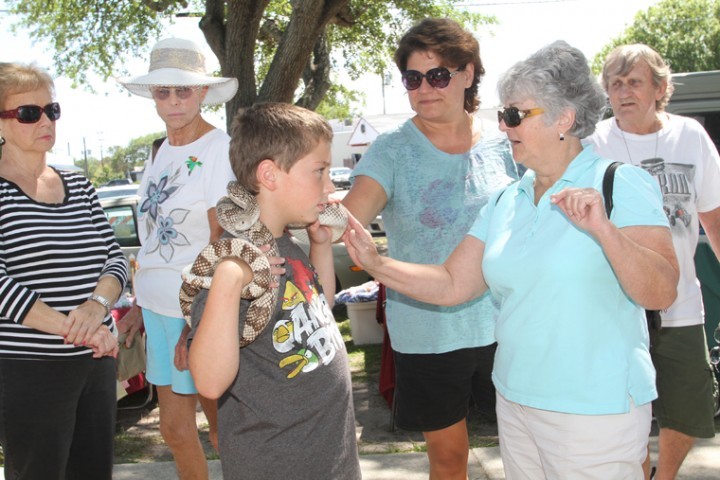
SEBASTIAN — The graceful swoop of two released pelicans could be seen overhead as the opening ceremony took place of the 20th Annual Pelican Island Wildlife Festival on Saturday morning. These large birds, with 10-foot wing-spans, were striking to behold; magnificent, in fact, as the crowd cheered.
What seems an ordinary sight to those who live on the barrier island, these Brown Pelicans seemed to be a symbol of the magical elements of the Indian River. These magnificent birds looked beautiful against the backdrop of a cloudless blue sky as they soared away in freedom.
Everyone present seemed to be equally inspired. A large crowd of over 5,000 visited throughout the day for this annual event to recognize and educate the community about Treasure Coast’s natural resources.
The Pelican Island Preservation Society organized this local festival at Sebastian’s Riverview Park in celebration of the 109th birthday of Pelican Island National Wildlife Refuge.
Dozens of exhibitors lined the sidewalks, including arts & crafts activities, environmental exhibits, and food vendors. Live wildlife shows, tours by pontoon boats, special kid’s programs and live music were offered nonstop throughout the day.
Among many attractions and activities of the day was the “Native Animals of Florida” exhibition, which was one of the favorite stopping points. This unique focal point was hosted by the Treasure Coast Wildlife Center, which was responsible for the successful rehabilitation of the opening pelican’s release.
“Without intervention, none of these animals – and hundreds of others like them – would survive,” said Regina Murphy, volunteer from the Treasure Coast Wildlife Center Hospital.
“The Treasure Coast Wildlife Center takes care of hundreds of sick, injured, and orphaned wild animals per year,” Murphy explained.
Among animals displayed in this popular exhibit were rehabilitating birds such as a handsome Bald Eagle, an adorable Barn Owl, and a stunning Red Shouldered Hawk. Children and adults of all ages seemed captivated by their close glimpse of extraordinary nature.
Equally spellbinding was the neighboring display of a live reptile show hosted by the Treasure Coast Herpetological Society. Snakes and endangered reptiles were present, which kept the crowd fascinated and enraptured.
The event was as entertaining as it was educational. The emcee and on the center stage of the festival was Teddy Roosevelt himself, or at least the closest thing in sight and sound.
Performed by the historical re-enactment of Joe Wiegand who has studied President Roosevelt extensively and has educated audiences throughout the country specifically focused on President Roosevelt’s unique role in the local environmental history here on the Treasure Coast.
“Today is all about how the actions of one single man, Sebastian’s own Paul Kroegel, played an important role in national historic change,” said Kevin Lowry, Visitor Services Manager of the Pelican Island Wildlife Refuge, U.S. Fish and Wildlife Service.
In 1881, Kroegel moved to the Indian River area and viewed the slaughtering of Brown Pelicans and other birds for their feathers, which were highly valued in the fashion industry. At the urging of Kroegel and the Audubon Society, President Theodore Roosevelt signed an executive order on March 14, 1903, that permanently set aside the island as a wildlife sanctuary; and made Pelican Island the first National Wildlife Refuge.
Since then, the National Wildlife Refuge system has grown to become the world’s largest network of lands managed for wildlife with over 500 refuges throughout the country totaling over 93 million acres.
“None of us would be standing here today if it wasn’t for Paul Kroegel. Teddy Roosevelt became involved because of this one man’s belief that wildlife and nature needed to be preserved and honored, not senselessly destroyed or wasted,” said Lowry. “The Pelican Island National Wildlife Refuge is the most biologically diverse estuary in the United States,” Lowry said, “It also provides habitat for the endangered manatee, contains large parcels of Florida’s east coast mangrove forests and salt marshes.”
The dedicated group that works tirelessly in partnership with the U.S. Fish and Wildlife Services is the 300-member Pelican Island Preservation Society, also known as PIPS.
“The Pelican Island Preservation Society is the public support organization for the Pelican Island National Wildlife Refuge. This is the only way for the public to directly support the refuge financially, as the federal government cannot accept donations,” said Pelican Island Preservation Society’s President Kristen Beck. “The Pelican Island National Wildlife Refuge is as historic as it is vastly important to our local habitat.”
“That is what this festival is about,” continued Beck. “Our group are the ‘friends’ of the National Wildlife Refuge and are committed to continued partnership, support and public education.”
The most recent Pelican Island Preservation Society projects completed by their membership were the building of the Centennial Trail and the Joe Michael Memorial Trail Overlook.
In the “Wildlife Not for Sale” exhibit, a display of products using endangered species both obtained inside and outside of the United States.
“Sometimes we pick up items we aren’t even fully aware where they came from or from what circumstances,” said Trish Adams, Biologist, from the U.S. Fish and Wildlife Service, ecological services office in Vero.
“This has been a very educational day for so many. There is so much to learn and appreciate about our local environment. It is also important that we balance the needs of wildlife conservation with the importance of economic growth.” Adams continued. “The more educated we become, the better off we all are.”
“Wild beasts and birds are by right not the property merely of the people who are alive today, but the property of unknown generations, whose belongings we have no right to squander.”
– President Theodore Roosevelt



